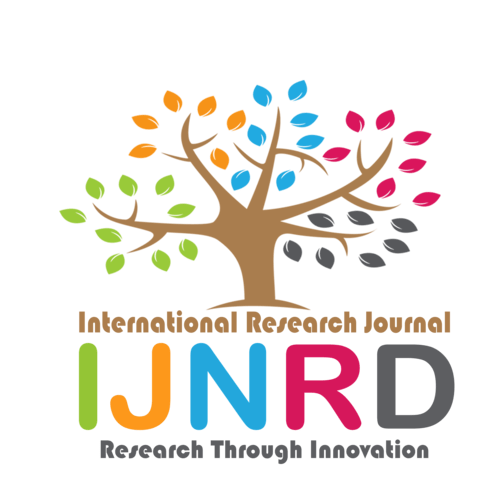|
|||||||||||||||

|
INTERNATIONAL JOURNAL OF NOVEL RESEARCH AND DEVELOPMENT International Peer Reviewed & Refereed Journals, Open Access Journal ISSN Approved Journal No: 2456-4184 | Impact factor: 8.76 | ESTD Year: 2016 Scholarly open access journals, Peer-reviewed, and Refereed Journals, Impact factor 8.76 (Calculate by google scholar and Semantic Scholar | AI-Powered Research Tool) , Multidisciplinary, Monthly, Indexing in all major database & Metadata, Citation Generator, Digital Object Identifier(DOI) |
||||||||||||||
Issue: April 2024
Volume 9 | Issue 4
Review Result and Publication of Paper within : 2-3 days
Click Here For more DetailsFor Authors
Forms / Download
Published Issue Details
Editorial Board
Other IMP Links
Facts & Figure
Impact Factor : 8.76
Issue per Year : 12
Volume Published : 9
Issue Published : 95
Article Submitted :
Article Published :
Total Authors :
Total Reviewer :
Total Countries :
Indexing Partner
Join RMS/Earn 300
Licence
This work is licensed under a Creative Commons Attribution-NonCommercial 4.0 International License







|
Published Paper Details
|
|
| Paper Title: | Clinical outcomes of a fully resorbable biosynthetic mesh (Poly-4-hydroxybutyrate) for abdominal wall hernia repair: our experience in India |
| Authors Name: | Dr. Neeraj Goyal , Dr. Shraiya Umashankar Tiwari , Dr. Gangadharabhatla Padmini |
| Download E-Certificate: | Download |
| Author Reg. ID: |
IJNRD_188225
|
| Published Paper Id: | IJNRD2303048 |
| Published In: | Volume 8 Issue 3, March-2023 |
| DOI: | |
| Abstract: | Abstract : Introduction: In past decade, poly–4-hydroxybutyrate (P4HB) a biosynthetic fully resorbable mesh which can serve as a potential alternative to biologic and traditional synthetic meshes in abdominal wall hernia repair, circumventing issues associated with both has been introduced. Present study aims to assess assessing the clinical outcomes associated with P4HB in abdominal wall hernia repair in Indian population. Patients and methods: A total of 25 patients at our center who underwent abdominal wall hernia repair with P4HB mesh was retrospectively reviewed to assess the postoperative outcomes associated with this mesh. The primary endpoints include the rate of recurrence and the rate of surgical site occurrence. Results: 25 patients were included (16 women, 9 men) with an average age of 49 years and average BMI of 28.9 kg/m2. High risk comorbidities included were obesity (12%), hypertension (48%), diabetes mellitus (20%), asthma (4%), hypothyroidism (20%), coronary artery disease (8%) and malignancy (4%). Hernia types included were umbilical (40%), infraumbilical (20%), epigastric (8%), Incisional (20%), right lumbar (4%) and inguinal (8%). Mean defect area was 24.96 cm2. Hernias were repaired by open onlay approach in 8 patients, laparoscopic intraperitoneal onlay mesh in 15 patients and laparoscopic totally extraperitoneal in the 2 inguinal hernia patients. At an average follow up of 18 months, only one patient developed a hernia recurrence, two patients developed surgical site infection managed conservatively and one patient complained of heaviness at the site of mesh. No patient developed a seroma/ hematoma/mesh infection/enterocutaneous fistula/need for reoperation. Conclusion: Study data demonstrates that P4HB mesh for abdominal wall hernia repair has a favorable outcome, acceptable recurrence rate and low rate of complications. This study supports P4HB mesh as an effective and safe biomaterial for abdominal wall hernia repair. |
| Keywords: | Abdominal hernia, resorbable biosynthetic mesh, mesh infection. |
| Cite Article: | "Clinical outcomes of a fully resorbable biosynthetic mesh (Poly-4-hydroxybutyrate) for abdominal wall hernia repair: our experience in India", International Journal of Novel Research and Development (www.ijnrd.org), ISSN:2456-4184, Vol.8, Issue 3, page no.a448-a452, March-2023, Available :http://www.ijnrd.org/papers/IJNRD2303048.pdf |
| Downloads: | 000118752 |
| ISSN: |
2456-4184 | IMPACT FACTOR: 8.76 Calculated By Google Scholar| ESTD YEAR: 2016 An International Scholarly Open Access Journal, Peer-Reviewed, Refereed Journal Impact Factor 8.76 Calculate by Google Scholar and Semantic Scholar | AI-Powered Research Tool, Multidisciplinary, Monthly, Multilanguage Journal Indexing in All Major Database & Metadata, Citation Generator |
| Publication Details: |
Published Paper ID:IJNRD2303048 Registration ID: 188225 Published In: Volume 8 Issue 3, March-2023 DOI (Digital Object Identifier): Page No: a448-a452 Country: New Delhi, New Delhi, India Research Area: Medical Science Publisher : IJ Publication Published Paper URL : https://www.ijnrd.org/viewpaperforall?paper=IJNRD2303048 Published Paper PDF: https://www.ijnrd.org/papers/IJNRD2303048 |
| Share Article: | |
|
Click Here to Download This Article |
|
| Article Preview | |
|
|
|
Major Indexing from www.ijnrd.org
| Semantic Scholar | Microsaoft Academic | ORCID | Zenodo |
| Google Scholar | ResearcherID Thomson Reuters | Mendeley : reference manager | Academia.edu |
| arXiv.org : cornell university library | Research Gate | CiteSeerX | PUBLON |
| DRJI | SSRN | Scribd | DocStoc |
ISSN Details
 |
 |
ISSN: 2456-4184
Impact Factor: 8.76 and ISSN APPROVED
Journal Starting Year (ESTD) : 2016
DOI (A digital object identifier)
Conference
Open Access License Policy
Important Details
Social Media
| Copyright © 2024 - All Rights Reserved - IJNRD |












Facebook Twitter Instagram LinkedIn